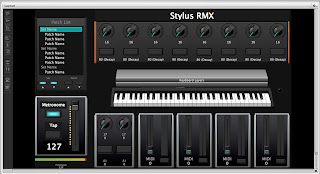Now that you have a pretty good idea what Mainstage looks like in a live setting and what makes up that performance, it's time to take a peak at how you customize the actual layout of what you see on the screen. To make these changes we'll go to the Layout Page and look at what you have to work with.
Layout Section
 This section is what takes up most of the screen and EVERYTHING in it can be moved, resized, deleted, re-named, etc. to be customized to the way you want to use Mainstage. The possibilities are endless and are only limited by your imagination.
This section is what takes up most of the screen and EVERYTHING in it can be moved, resized, deleted, re-named, etc. to be customized to the way you want to use Mainstage. The possibilities are endless and are only limited by your imagination. You can create a guitar rig with different amps and effects, you can add a looper, you can have lyrics, level meters, and on and on. What I have found in creating a layout is I usually mimic a combination of my controller layout and the way the software synths work within it's own interface. In the screenshot of my most recent layout you can see that I have setup things that I trigger live and need to have visual reference of. Here's a list of what I have created in my layout screen:
- List of keyboard patches
- On & Off, volume control, and current tempo for my click track (metronome)
- CPU meter so I can monitor my computers performance at all times
- Stylus RMX Control Pannel - Start/Stop 8 drum loops with independent volume controls
- Keyboard with layers
- Effects module - Reverb & Delay with independent wet/dry and mute controls (next to metronome)
- Volume control, mute, and level meters for 4 separate outputs on my audio interface
Pads, buttons, and sliders on my MIDI controller have been assigned to everything on the screen so I can have complete control in a live situation without needing to touch the laptop. Which brings me to the Screen Control Inspector which makes it easy to assign the knobs and buttons you put on the screen to your MIDI controller whether it's a keyboard or foot controller.
This is the section where you can easily assign your screen controls to a physical controller. The easiest way to do this is to click the on screen control you want to assign to your controller, click the "Learn" button, and then move the knob or press the button you want to assign to it. You'll see it grab or light up and your that's it! Now all you have to do is just select the next on screen control and it will stay in "Learn" mode so you can quickly assign all of your controls. You can also set the color and label of the control as well as have access to in-depth editing to the MIDI channel, number, type, etc.
Screen Control Palette
Essentially this is where all the different types of controls Mainstage uses can be pulled from to add to your layout. All you have to do is drag and drop the control of your choice to your layout. If you see a number by a control it tells you it's a group so when you drag it to the layout screen it will create that many identical controls for you at once.
You can also create your own grouped controls. For example I created a group that included a level meter, volume control, and mute button so anytime I want an easy way to control and monitor an output on my audio interface I just drag the group to my layout and assign it accordingly. This can really save you tons of time when designing other layouts our when you're trying to re-work an existing one. I enlarged the section and took a screen shot so that you can see more of the controls that are available in this section.
You can also create your own grouped controls. For example I created a group that included a level meter, volume control, and mute button so anytime I want an easy way to control and monitor an output on my audio interface I just drag the group to my layout and assign it accordingly. This can really save you tons of time when designing other layouts our when you're trying to re-work an existing one. I enlarged the section and took a screen shot so that you can see more of the controls that are available in this section.
Hopefully this helped you understand just how flexible and creative this program can be and how it can be used for many different things not just keyboards! In fact, Mainstage comes with several templates for Vocals, Guitars, and Audio Mixers to help jump start your creative juices.




this may be a ridiculous question, but could you make a video explaining how you set up/route everything? I am trying to use all the elements I see here (mainstage with pads along with stylus RMX and click). I am new to mainstage and stylus and would love to see step by step how you get it all loaded up. Thank you.
ReplyDelete-Brian
That is a GREAT suggestion Brian. Let me see what I can do. In the mean time I will put together some posts that walk you step by step through setting up the different elements you are talking about.
ReplyDeleteJust posted the first video in a series designed to teach you how to setup Stylus RMX in Mainstage. Enjoy!
ReplyDeleteThis blog is such a huge help for me. Thank you so much, bro. Your ministry reaches farther than you may know.
ReplyDelete